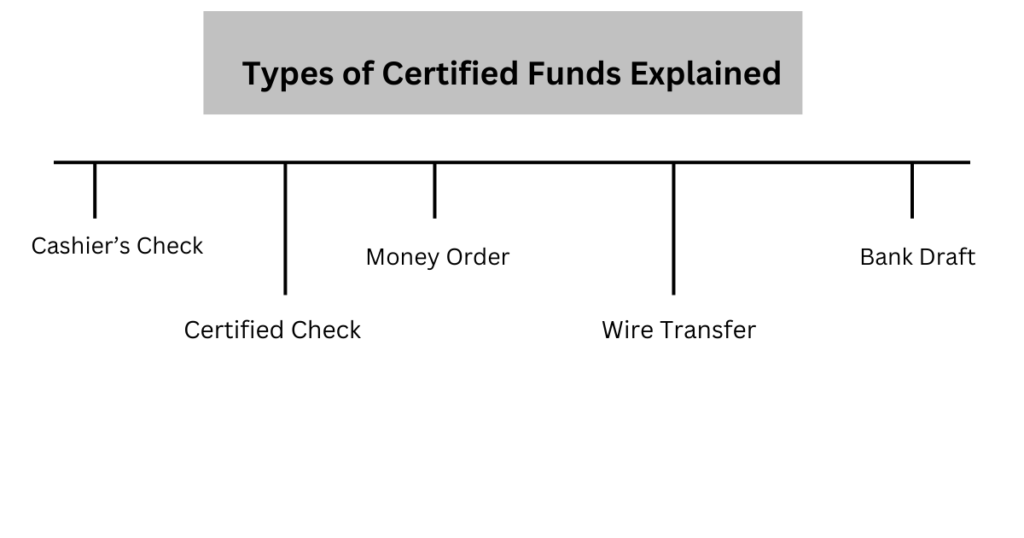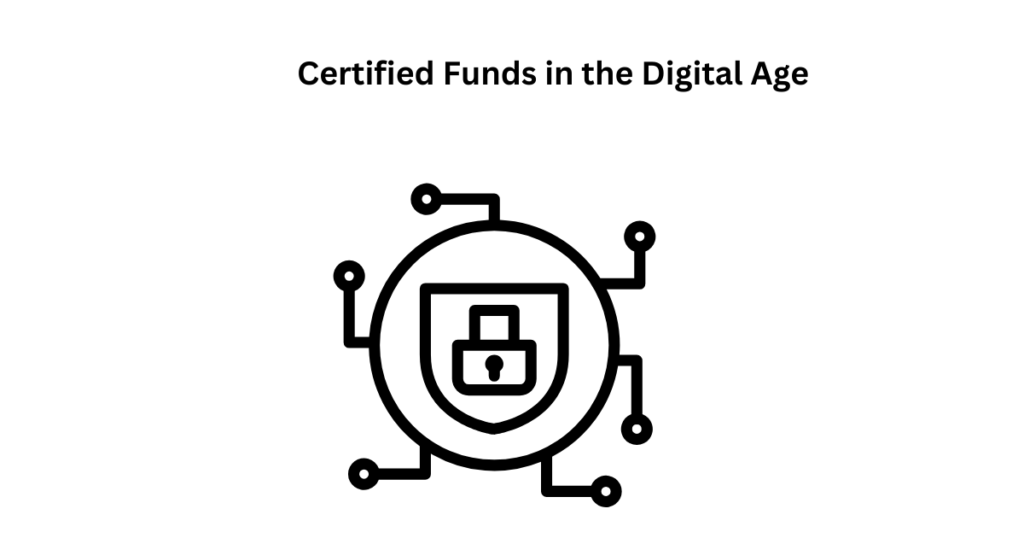Introduction to Certified Fund
Certified funds refer to a type of payment that is guaranteed by a bank or financial institution to be valid and available for settlement. This assurance means the funds will clear without issues. The term is primarily used in North America, especially in real estate transactions.
In high-value transactions—like buying property, vehicles, or any asset that involves transferring a title—sellers typically require a secure and guaranteed form of payment to ensure that the buyer can fulfill their financial obligation.
What Are Certified Funds and Why Do They Matter?
Certified funds are a secure way to pay for goods, services, or obligations when trust and certainty are essential. Unlike personal checks or cash, funds guarantee that the money is available and reserved for the recipient. They’re commonly used in situations where large sums are involved, and both parties need assurance that the payment won’t bounce. But what exactly makes certified funds so special, and why do they matter in today’s fast-paced financial world?
Certified funds act as a bridge between traditional cash and modern digital payments, offering a reliable option when regular methods fall short. Whether you’re buying a house, settling a legal dispute, or closing a business deal, certified funds provide peace of mind by ensuring the money is real and ready to use. In this article, we’ll explore everything you need to know about funds, from how they work to their role in secure transactions.
The Evolution of Secure Payments: From Paper to Digital
Payments have come a long way. Centuries ago, people traded goods or used coins to settle debts. Then came paper money, checks, and eventually digital payments like credit cards and apps. Certified funds evolved as a response to the need for secure, guaranteed payments when cash wasn’t practical, and personal checks weren’t trusted. Today, certified funds include options like cashier’s checks, money orders, and wire transfers—each offering a layer of protection that’s hard to beat. As technology advances, funds are adapting too, with digital versions and even blockchain entering the picture.
Who Typically Uses Certified Funds and In What Situations?
Certified funds are popular among people and businesses dealing with high-stakes transactions. Homebuyers use them for down payments, lawyers rely on them for settlements, and companies turn to them for major purchases. Essentially, anyone who needs to prove they have the money—and that it’s safe—might opt for certified funds. They’re especially common when dealing with strangers or in situations where delays or fraud could cause big problems.
MUST READ: What Does Max-Funded IUL Mean
How Certified Funds Work
The Verification Process Behind Certified Funds
Certified funds aren’t just promises—they’re backed by a bank or financial institution. When you request certified funds, the issuer (like a bank) verifies that you have enough money in your account. They then set that amount aside, ensuring it can’t be spent elsewhere. This process makes funds a trusted option because the recipient knows the payment is secure before accepting it.
Who Certifies the Funds and How It’s Done
Banks, credit unions, and sometimes post offices certify funds. For example, when you request a cashier’s check, the bank withdraws the money from your account and issues a check in its own name. For a certified check, the bank stamps your personal check to confirm the funds are available. The key is that a trusted third party guarantees the payment, making funds more reliable than regular methods.
Common Misconceptions About Certified Payments
Some people think certified funds are the same as cash or that they’re immune to fraud. While they’re very secure, they’re not foolproof—forgery can still happen. Others assume certified funds are free or instant, but fees and processing times often apply. Understanding these details helps you use funds effectively.
MUST READ: Top Stock Market Movies and Web Series :Must Watch
Types of Certified Funds Explained

Overview of Certified Payment Instruments
Certified funds come in multiple forms:
-
Cashier’s Check
-
Certified Check
-
Money Order
-
Wire Transfer
-
Bank Draft
Differences Between Each Method and When to Use Them
| Method | Ideal Use Case | Processing Time | Cost |
|---|---|---|---|
| Cashier’s Check | Real estate, legal payments | 1–2 days | Low–Medium |
| Certified Check | Mid-sized purchases | Immediate | Low |
| Money Order | Small payments, under $1,000 | Immediate | Very Low |
| Wire Transfer | Urgent, international transfers | Minutes–Hours | Medium–High |
| Bank Draft | International payments with proof | 1–5 business days | Varies |
Cashier’s Check
What It Is and How It Works
A cashier’s check is issued by the bank and drawn on the bank’s own funds, not your personal account. You pay the bank upfront, and they handle the rest.
When to Use a Cashier’s Check
-
Buying a home or vehicle
-
Paying a legal judgment
-
Large business transactions
Pros and Cons of Cashier’s Checks
Pros:
-
Backed by the bank
-
Widely accepted
-
Relatively fast
Cons:
-
Fees apply
-
Can be forged (verify always)
Is debit card certified funds
When purchasing a cashier’s check, you must pay the full amount upfront using cash, a debit card, or another verified payment method. Credit cards are not accepted for buying official checks like cashier’s checks.
In simple terms, you need to have sufficient funds available at the time of purchase. If you’re paying with a personal check, the bank may place a hold until the check clears to ensure the funds are valid.
It’s also important to be aware of the fees involved. Most banks and financial institutions charge a fee for issuing a cashier’s check, typically between $5 and $15. However, the fee can vary based on the bank and the amount being issued—larger amounts may incur higher charges.
MUST READ: Decoding Your Credit Card Statement: A Deep Dive into the Minimum Due
Money Order
What Is a Money Order and How It’s Issued
A money order is a prepaid certificate you can purchase from banks, post offices, or stores. It’s usually for smaller amounts (under $1,000).
Ideal Use Cases for Money Orders
-
Paying rent
-
Sending money by mail
-
When you don’t have a bank account
Limitations and Risks
-
Low limits
-
Can be lost or stolen
-
Some people don’t accept them
Wire Transfer
How Wire Transfers Ensure Secure Payments
Wire transfers move money directly from one bank to another. Once sent, the funds are typically available the same day.
Domestic vs. International Wire Transfers
-
Domestic: Faster and cheaper
-
International: Slower, costlier, currency conversion needed
Fees and Timelines Involved
-
Domestic: $10–$30
-
International: $30–$60
-
Timeline: Minutes to 3 days
Certified Check
What Makes a Check “Certified”?
A certified check is a personal check that your bank verifies, signs, and sets aside the funds for. It’s your money, but confirmed and frozen by the bank.
Key Differences Between Certified and Cashier’s Checks
| Feature | Certified Check | Cashier’s Check |
|---|---|---|
| Drawn From | Your account | Bank’s account |
| Issued By | Bank verifies yours | Bank prints it |
| Risk | Slightly higher | Lower |
Bank Draft
How Bank Drafts Work
A bank draft is a check issued by a bank on behalf of a customer, typically for international use. Funds are withdrawn first, then the draft is issued.
Bank Draft vs. Wire Transfer: What’s Better?
-
Bank Draft: More formal, slower, often used in legal or official deals
-
Wire Transfer: Faster but can be harder to reverse
How to Send Certified Funds
There are several methods for sending certified funds, each with its own process:
To get a cashier’s check, you typically need to visit a bank branch in person, where a teller will assist you. Once issued, you can deliver the physical check directly to the recipient.
For wire transfers, many banks offer online services, or you can set one up with the help of a bank teller at a branch.
To obtain a money order, you’ll need to visit a nearby retailer. After receiving it, you must hand it over to the recipient in person. It’s generally not advisable to send money orders through the mail due to security concerns.
Step-by-Step Guide to Sending Certified Payments
- Choose your method (e.g., cashier’s check).
- Visit a bank or issuer.
- Provide funds and recipient details.
- Pay any fees.
- Deliver the payment securely.
Documents and Details Required
You’ll need ID, the recipient’s name, and the exact amount. Some methods require your account details.
Where to Get Certified Funds: Banks, Credit Unions, and More
Banks and credit unions offer most options, while post offices and stores sell money orders.
Why Certified Funds Are Crucial in High-Value Transactions
Real Estate, Business Deals, and Legal Payments
In real estate, certified funds ensure a down payment clears. Businesses use them for equipment purchases, and courts require them for settlements.
Avoiding Fraud and Chargebacks
Unlike cards or checks, certified funds can’t be reversed easily, protecting both sides.
Peace of Mind for Buyers and Sellers
Knowing the money is secure reduces stress in big deals.
MUST READ: what is flexi cap fund Your Ultimate Guide to flexi cap fund
How to Obtain Certified Funds
Visiting a Bank or Credit Union
Head to your branch with cash or account access.
What Identification and Information You’ll Need
Bring a driver’s license or passport and the payment amount.
Costs and Fees Associated with Each Method
Cashier’s checks might cost $10, wire transfers up to $50, and money orders a few dollars.
Certified Funds vs. Traditional Payments
Why Personal Checks and Debit Cards May Not Suffice
Personal checks can bounce, and debit cards lack the formality of certified funds.
Case Study: Payment Disputes and Certified Fund Advantages
Imagine a car sale gone wrong—a personal check bounces, but a cashier’s check would’ve settled it instantly.
Security Features of Certified Funds
To prevent forgery, certain security measures are often applied to certified funds. These may include distinctive stamps, specialized inks, hole punches, or machines like a protectograph. However, despite these precautions, it’s still possible for someone to fraudulently remove the original payee’s name and replace it with their own.
Unfortunately, many money order providers—such as Western Union—do not offer reimbursement in cases of fraud. Victims must often report such incidents to local law enforcement. In some cases, the offender may attempt to avoid responsibility by claiming it was a case of identity theft. Fraudulent money orders are sometimes obtained through unsecured locations, such as rent drop boxes.
Can Blockchain Enhance Certified Fund Security?
Introduction to Blockchain and Its Relevance
Blockchain is a digital ledger that records transactions securely. It could make certified funds even safer.
Smart Contracts and Transparent Transactions
Smart contracts could automate certified fund transfers with clear rules.
Future-Proofing Certified Funds
Blockchain might reduce fraud and speed up processes.
Certified Funds vs. Cryptocurrency Transactions
Cryptocurrency Transaction Security
Anonymity, Decentralization, and Risks
Crypto offers privacy but lacks oversight, risking scams.
Certified Funds Security
Traditional Methods, Verified Identities
funds rely on banks and clear identities.
Comparing the Two
Which Is Safer and More Reliable?
funds win for trust; crypto is riskier.
Which Is More Widely Accepted in Legal/Corporate Settings?
funds dominate official transactions.
Benefits of Integrating Certified Fund with Blockchain
Creating a Hybrid Payment System
Combining bank guarantees with blockchain speed could revolutionize payments.
Smart Escrow and Conditional Transfers
Funds release only when conditions are met.
Improved Tracking and Transparency
Every step becomes traceable.
Common Use Cases for Certified Fund
Buying Real Estate and Vehicles
Down payments and titles often require certified funds.
Court Settlements and Legal Obligations
Judges demand guaranteed payments.
Large-Scale Business Transactions
Companies trust funds for big deals.
Potential Drawbacks of Certified Funds
Costs, Delays, and Inconvenience
-
You have to visit a bank (sometimes in person).
-
You may pay high fees for wire transfers.
-
Processing times vary—some methods take days.
Limited Acceptance in Some Sectors
Smaller businesses or individuals may not accept certified checks or drafts if they’ve had bad experiences with forgeries.
Risks of Forgery Despite Protections
Yes, funds can be forged. Always verify the instrument by contacting the issuing institution.
Certified Funds in the Digital Age

Are Digital Certified Funds a Reality?
E-checks and online wires are emerging.
The Rise of E-Certified Payments
Apps and portals make funds faster.
How Financial Tech Is Reshaping Secure Transactions
Tech cuts delays while keeping security high.
Global Regulations Around Certified Funds

How Rules Differ by Country
Some countries have strict regulations around funds, especially when it comes to preventing money laundering. Others are more relaxed.
Compliance and Reporting Standards
Large certified fund transfers may require:
-
Source-of-funds verification
-
Recipient identity verification
-
Currency conversion approvals
International Banking Protocols
SWIFT codes, IBAN numbers, and real-time tracking are being adopted globally to make certified payments more standardized and safer across borders.
Summary & Final Thoughts
Certified funds are the cornerstone of secure, high-value transactions. Whether you’re buying a home, paying a legal settlement, or closing a business deal, certified funds ensure trust and verification on both sides.
In a world increasingly driven by speed and tech, certified funds are evolving—blockchain, smart contracts, and digital certifications are reshaping how we send guaranteed money. But at the core, the principle remains unchanged: secure payments backed by verifiable institutions.
Always choose the right method based on your needs, verify before accepting, and embrace the future of secure financial transactions.
Frequently Asked Questions (FAQ)
What is the difference between a cashier’s check and a certified check?
A cashier’s check is bank-issued; a certified check is yours, verified by the bank.
Are certified funds refundable?
Not easily—once issued, they’re hard to cancel unless lost or stolen.
How can I verify if a certified check is real?
Call the issuing bank with the check number.
Are there digital alternatives to certified funds?
Yes, e-wires and digital checks are growing.
Is it safe to accept certified funds from a stranger?
Usually, but verify with the bank first.
How long does it take to clear certified funds?
Often instant, but some take 1-2 days.
What fees are associated with sending certified funds?
From $1 for money orders to $50 for wires.
Can certified funds be cancelled or stopped?
Only under specific conditions, like loss.
What’s the safest method of certified payment for international transactions?
Wire transfers are top for global use.
Can cryptocurrencies be considered certified funds?
No, they lack bank backing and legal status.
Riyo is a Digital Marketing expert with specialization in SEO and Market Analysis. He has hands-on experience in keyword research, on-page & off-page SEO, and data-driven marketing strategies. Riyo helps businesses boost their online visibility and grow through smart digital tactics.


